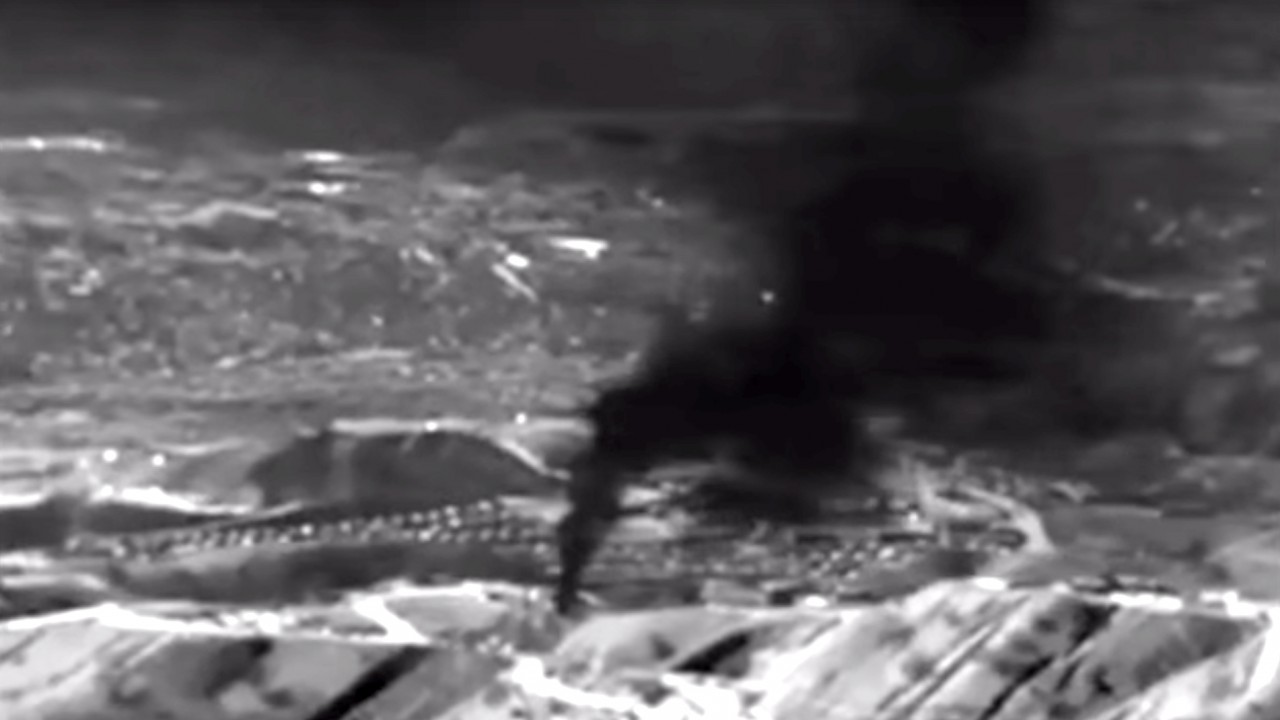
Aerial footage of a gas leak in the San Fernando Valley. (Environmental Defense Fund)
This post originally appeared at InsideClimate News.
In 2016, the US Environmental Protection Agency will issue long-awaited rules to control methane emissions from the oil and gas industry. The regulations will emerge after years of activism and scientific studies on the climate risk posed by methane, a powerful greenhouse gas that’s dozens of times more potent that carbon dioxide.
But the regulations will likely be overshadowed by the ongoing saga in Aliso Canyon, Calif., where a leaking natural gas storage field continues to belch thousands of tons of methane into the air every week.
The leak was detected on Oct. 23. Hundreds of residents in the Porter Ranch neighborhood of Los Angeles have relocated due to headaches, nausea, nosebleeds and other health effects. SoCal Gas, the utility that runs the facility, attributes the problem to a side effect of breathing in mercaptans — the odorizing chemical that’s added to natural gas to make leaks detectable.
— R. Rex Parris, attorney
But toxins such as hydrogen sulfide and benzene have been detected in the air, said R. Rex Parris, one of the attorneys representing people who live near the well.
These chemicals can cause severe short-term and long-term problems, including cancer, but scientists know little about how these mixtures affect public health over a period of months.
Parris said some residents have experienced more severe symptoms such as bleeding from the eyes and the gums.
“This wasn’t a leak, it was a blowout,” he said. His office, the R. Rex Parris Law Firm, is part of a coalition of firms representing more than 1,000 Porter Ranch residents. “That whole well blew. It’s the most massive leak in the history of this country in a populated area,” Parris said.
In November, California regulators took preliminary measurements and estimated the leak had increased the state’s entire methane footprint by a quarter. Additional data taken in December found the leak rate had dropped, but overall, the site was spewing 40 to 64 tons of methane per hour.
To put that number in context, a recent peer-reviewed study found that methane leaks from Texas’ Barnett Shale, a field that produces 7 percent of the nation’s natural gas, had an average leak rate of 65 tons per hour.
This means the Aliso Canyon well is emitting 62 to 98 percent as much methane per hour as the entire Barnett Shale.
— Amy Townsend-Small, University of Cincinnati professor
Amy Townsend-Small, a University of Cincinnati professor who’s studied methane emissions from the natural gas industry, said the size of the leak is staggering.
“It’s a perfect example of how we can work on decreasing emissions from individual wells, but there’s going to be catastrophic events…and that can change everything,” she said.
After six failed attempts to plug the leak, SoCal Gas said it will fix the problem by drilling a relief well — a process that will take three to four months. The company is simultaneously exploring other solutions, including pumping fluids into the well, SoCal spokeswoman Trisha Muse said in an email.
The leak stems from a pipe in an 8,700-foot well. Diagnostic tests show the leak is occurring in a shallow part of the well, less than 500 feet underground, Muse said.
“Relief wells are a proven approach to shutting down oil and gas wells,” she wrote. Once the relief well reaches the leaking well, SoCal will pump in cement to seal off the leak. That well will then be permanently abandoned, Muse said.
The complex process of locating and plugging the underground leak has drawn comparisons to the 2010 Deepwater Horizon oil spill that continued for months in the Gulf of Mexico.
Meanwhile, thousands of Porter Ranch residents have been unable to move out of their homes, Parris said. Although SoCal will pay upfront for residents to move into hotel rooms, that’s impractical for families with children, he said. Those families need an apartment or a house, and many can’t afford to pay upfront for rental housing on top of their existing mortgages.
Melissa Bailey, a SoCal spokeswoman, said affected residents can work with the company’s 15 relocation agents to find temporary housing. SoCal “will pay for it directly—100 %,” she wrote in an email. “This process can take time.” Families who choose to find their own housing will be “reimbursed as quickly as possible,” she said.
Parris and his colleagues have filed numerous lawsuits against SoCal and the government seeking damages and additional information on air quality data.
Sam Atwood, media relations manager for the South Coast Air Quality Management District, said his agency took seven “grab samples” to test for pollutants between late October and mid-December. One of the samples, from Nov. 3, detected benzene levels three to five times higher than those seen in urban Los Angeles. Atwood said his agency is adding more sophisticated air monitoring equipment to track the situation.
There’s never been a situation like this, so “nobody knows” what the long-term health effects will be, Parris said.
Republished with permission of InsideClimate News, a non-profit, non-partisan news organization that covers energy and climate change—plus the territory in between where law, policy and public opinion are shaped.




